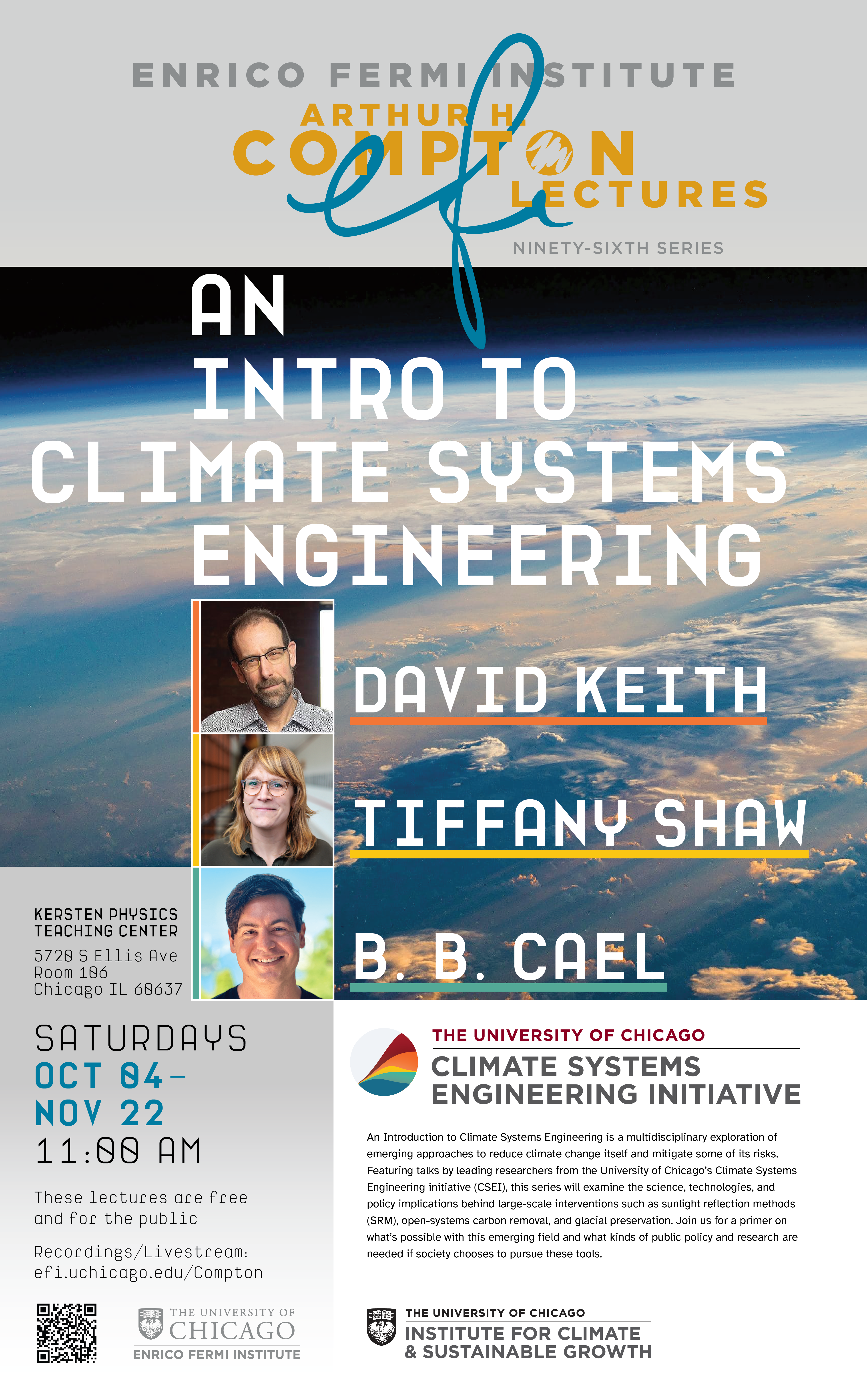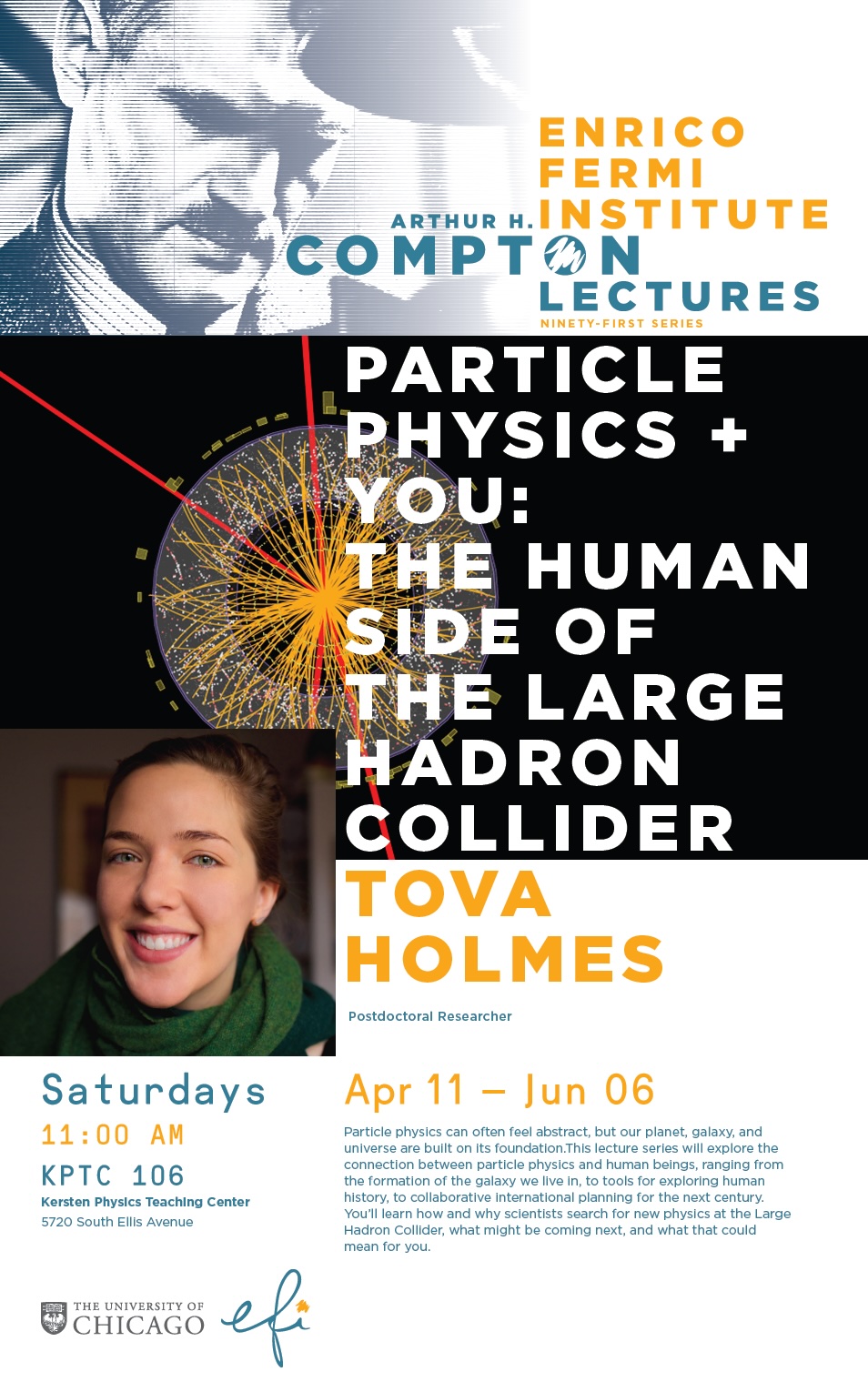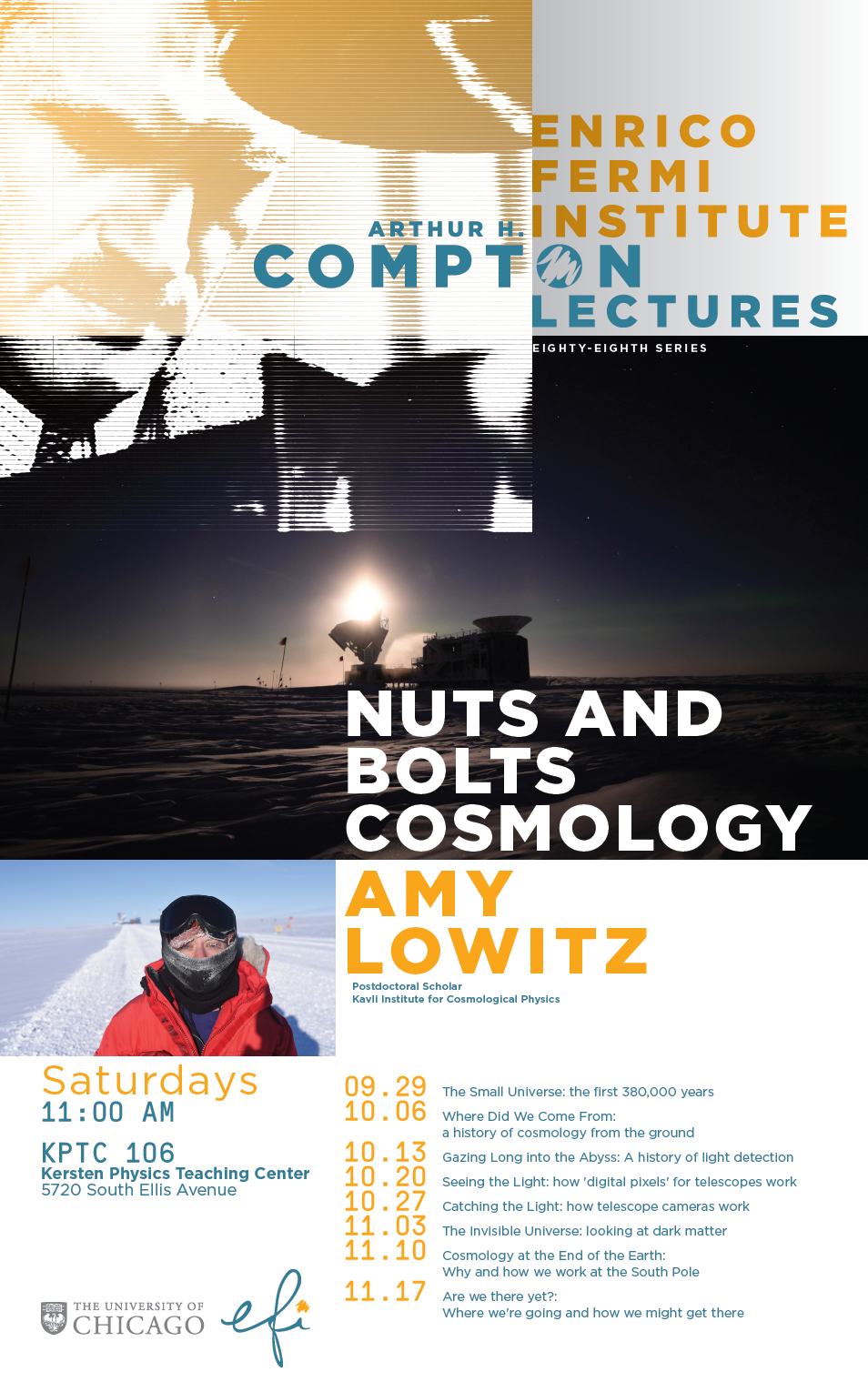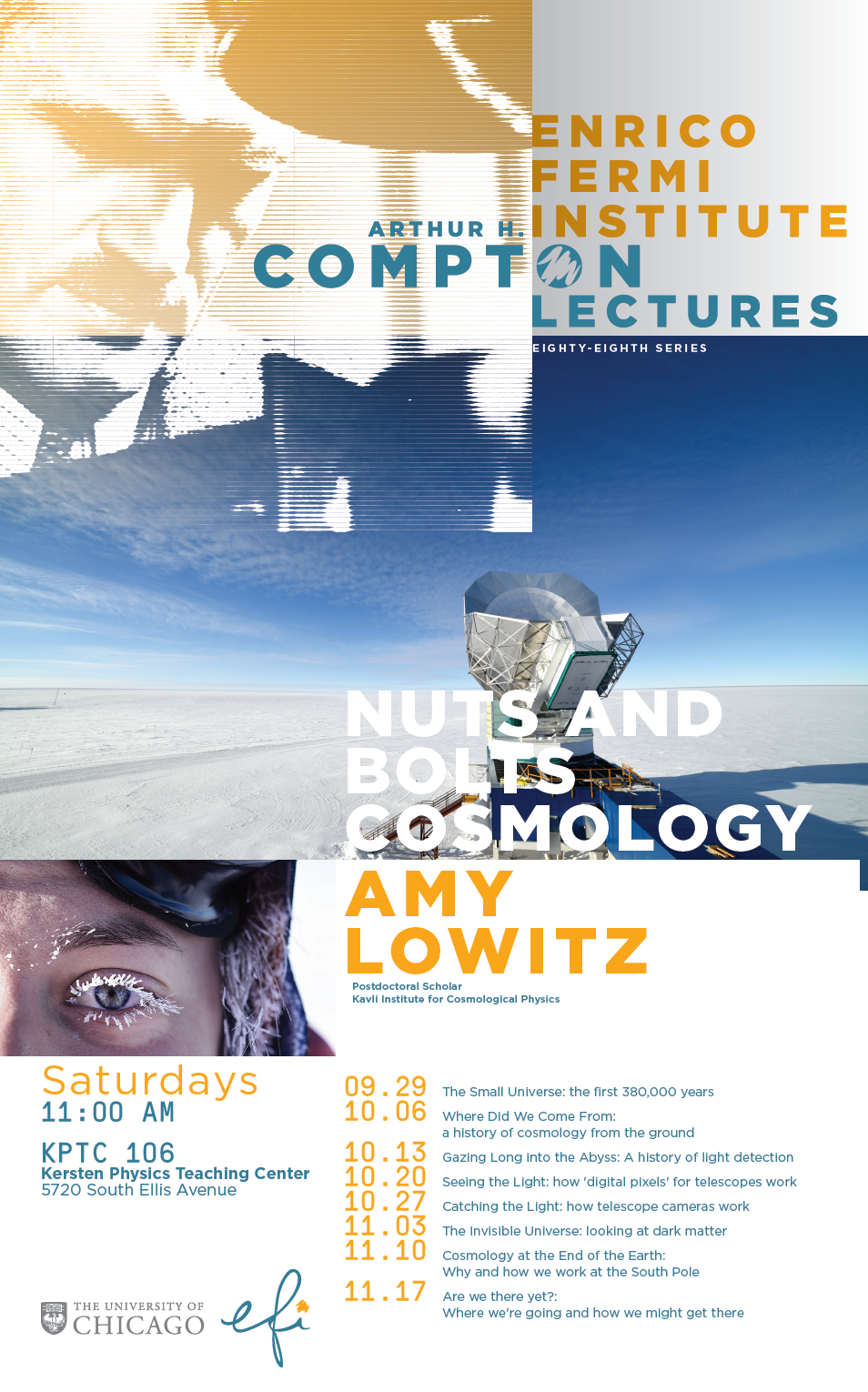An Introduction to Climate Systems Engineering by David Keith, Tiffany Shaw, B B Cael, David Archer and Doug MacAyeal
An Introduction to Climate Systems Engineering is a multidisciplinary exploration of emerging approaches to reduce climate change itself and mitigate some of its risks. Featuring talks by leading researchers from the University of Chicago’s Climate Systems Engineering initiative (CSEI), this series will examine the science, technologies, and policy implications behind large-scale interventions such as sunlight reflection methods (SRM), open-systems carbon removal, and glacial preservation. Join us for a primer on what’s possible with this emerging field and what kinds of public policy and research are needed if society chooses to pursue these tools.
Learn more about the Climate Systems Engineering Initiative at https://climateengineering.uchicago.edu
October 4, 2025
October 11, 2025
October 18, 2025
October 25, 2025
November 1, 2025
November 8, 2025
November 15, 2025
November 22, 2025
Neutrinos: Detectors and Discoveries by Thomas Wester
Neutrinos are everywhere — they come from the earth, the atmosphere, the sun, and the cosmos, and are
produced at particle accelerators and nuclear reactors. These pervasive particles have surprised and
inspired physicists since their first detection in 1956, and have been the subject of four Nobel prizes to
date. Studying neutrinos has challenged us to build some of the world’s largest and most advanced particle
detectors, both to learn about neutrinos themselves and to gain insight into the intricate processes that
produce them.
This series will explore neutrinos and the incredible machines built to detect them. We will discuss what
makes neutrinos unique, neutrino experiments, and current unsolved questions to see how these tiny
particles may lead to the next big discoveries in physics.
March 29, 2025
April 5, 2025
April 12, 2025
April 19, 2025
April 26, 2025
May 3, 2025
May 10, 2025
May 17, 2025
Understanding the Building Blocks of Nature with Particle Collisions and AI by Anthony Badea
Ultra-relativistic particle collisions provide unique access to the properties of quantum field theories at high energies and recreate in the laboratory the conditions of the early universe. Measurements at facilities such as the Large Hadron Collider have established that the Standard Model is a highly accurate theory of nature. There are, however, still major outstanding questions related to the early universe and the fields that drove its dynamics. To answer these questions, we are creating the next-generation of accelerator-based experiments and technology.
In this lecture series, we will discuss the forefront of research in particle physics. We will focus on accelerator based experiments to understand the conditions, objectives, and technology needs. In particular, we will highlight how new computing hardware and artificial intelligence (AI) are opening up novel experimental programs.
October 5, 2024
October 12, 2024
October 19, 2024
October 26, 2024
November 2, 2024
November 9, 2024
November 16, 2024
November 23, 2024
How Astrophysicists See the Universe by Christoph Welling
Astrophysics is a tricky business. Even the closest stars are trillions of miles away, too far to explore them up close any time soon. So astronomers and physicists have to rely on observations they can make from earth. To do this, every night, and day, a wide array of observatories all over the world are catching the light from distant galaxies, radio waves from the early universe and even ripples in space-time itself.
This is a lecture series about these telescopes and how they are used to learn about the universe. We will talk about how modern observatories work, and what the light they detect can tell us about the objects it came from. We will also discuss new types of observatories, that do not detect light, but other messengers, like cosmic rays, neutrinos or gravitational waves.
March 23, 2024
March 30, 2024
April 6, 2024
April 13, 2024
April 20, 2024
April 27, 2024
May 4, 2024
May 11, 2024
How Fundamental Science Has Changed the World: A Story of Invention and Discovery by Philipp Windischhofer
The world of today is a magical place. We talk to people on the other side of the planet at the push of a button, we cook our lunch by splitting the cores of heavy atoms, and we treat cancer with subatomic particles moving nearly as fast as light.
In this lecture series, we will explore the origins of the technological marvels of the present. We will see the world through the eyes of the scientists of the past, examine the experiments they conducted and explain the inner workings of the instruments they devised. Watching progress unfold over the centuries, from the nature of heat, to electricity, to the mystery of the atom, we will witness how scientific progress spurred technological innovation, but also how new technologies helped push back the frontiers of knowledge even further.
Wherever we look, we will find examples of the symbiosis between fundamental science and technology, a connection that has not only helped us understand our place in the universe, but that has also given us the power to shape it into a place worth living in.
September 30, 2023
October 7, 2023
October 14, 2023
October 21, 2023
October 28, 2023
November 4, 2023
November 11, 2023
November 18, 2023
Spring 2020, "Particle Physics + You: The Human Side of the Large Hadron Collider" by Tova Holmes Cancelled due to COVID
Spring 2019, "Symmetry and Symmetry Breaking" by Yu-Chen Tung
Autumn 2018, "Nuts and Bolts Cosmology" by Amy Lowitz
Spring 2018, "The Physics of Neutrinos: Progress and Puzzles" by Andrew Mastbaum
Autumn 2017, "Hellish or Hadean: The First 500 Million Years of Earth's Existence" by Patrick Boehnke
Spring 2017, "How and Why to Go Beyond the Discovery of the Higgs Boson" by John Alison
Autumn 2016, "Novel States of Matter: from Quantum Mechanics to Quantum Computing" by Matthew Roberts
Spring 2016, "The Soundtrack to the Universe: LIGO and the Detection of Gravity Waves" by Benjamin Farr
Autumn 2015, "The Cosmic Fireworks that Synthesize the Building Blocks of Life: Supernova Explosions" by Manos Chatzopoulos
Spring 2015, "Nature's Timepiece: The Exotic World of Pulsars" by Andrew McCann
Autumn 2014, "Shining Light on the Dark Side of the Universe" by Tim Linden
Spring 2014, "Cosmic Cartography - Exploring an Expanding Universe" by Elise Jennings
Autumn 2013, "Dissecting the Higgs Discovery: The Anatomy of a 21st Century Scientific Achievement" by Lauren Tompkins
Spring 2013, "Frustrating Geometry: Geometry and Incompatibility Shaping the World Around Us" by Efi Efrati
Autumn 2012, "Constructing the Solar System: A Smashing Success" by Thomas Davison
Spring 2012, "String Theory in the LHC Era" by Joseph Marsano
Autumn 2011, "Before the Beginning to After the End" by Mark Wyman
Spring 2011, "99 Years of Discovery: What Is Our Current Picture of Cosmic Rays?" by Nahee Park
Autumn 2010, "Particle Physics: What Has It Done for You Lately?" by Joseph Tuggle
Spring 2010, "The Physics of Stuff: Why Matter Is More than the Sum of Its Parts" by Justin Burton
Autumn 2009, "The Physics of Energy Devices" by Eric Switzer
Spring 2009, "From Quantum Mechanics to String Theory" by Nelia Mann
Autumn 2008, "Stars: Their Life and Afterlife" by Brian Humensky
Spring 2008, "Seeing and Believing: Detection, Measurement, and Inference in Experimental Physics" by Kathryn Schaffer
Autumn 2007, "Shining Light on Ultracold Atoms - Illuminating Complex Matters" by Nathan Gemelke
Spring 2007, "The Quest for Gamma Rays: Exploring the Most Violent Places in the Universe" by Elizabeth Hays
Autumn 2006, "Unsolved Mysteries of the Universe: Looking for Clues in Surprising Places" by Brian Odom
Spring 2006, "String Theory: With a View Towards Reality" by Nicholas Halmagyi
Autumn 2005, "Challenges to Seeing the Invisible: Foregrounds and Backgrounds in the Scientific Exploration of the Universe" by Dorothea Samtleben
Spring 2005, “The Story of Galaxy Formation in Our Universe” by Risa Wechsler
Autumn 2004, “The Origin of Mass in Particle Physics” by Ambreesh Gupta
Spring 2004, "The Age of Things: Sticks, Stones and the Universe" by Matthew Hedman
Autumn 2003, "Quantum Optics: From the Possible to the Actual" by Matthew Pelton
Spring 2003, "Cosmic Fireworks" by Frank Timmes
Autumn 2002, "Pursuit of the New Messengers: Astrophysics in the Extreme Universe" by Scott Wakely
Spring 2002, "Sketching the Biggest Picture---The Adventure of Experimental Cosmology" by Clem Pryke
Autumn 2001, "Invasions in Particle Physics" by Maria Spiropulu
Spring 2001, "Brown Dwarfs and Extrasolar Planets" by Edward Brown
Autumn 2000, "Anti-Matter" by Richard Kessler
Spring 2000, "The Power of Analogy in the Study of Complex Systems" by Haim Diamant
Autumn 1999, "Black Holes, Quantum Mechanics, and String Theory" by Finn Larsen
Spring 1999, "Exploring the Mysteries of Our Evolving Universe: Observational Tests of Big Bang Cosmology" by Joseph Mohr
Autumn 1998, "Challenges in Imaging" by Walter Wild
Spring 1998, "Solar Energy - The Future Option?" by Harald Ries
Autumn 1997, "The Chaos Revolution and Beyond: Physics in a Nonlinear World" by Shankar C. Venkataramani
Spring 1997, "Astronomy with Particles: How the Study of Cosmic Rays Became Astroparticle Physics" by Lucy F. Fortson
Autumn 1996, "Prometheus' Return: Myths and Misconceptions about Nuclear Science" by James J. Connell
Spring 1996, "Imag(in)ing the Universe: Novel Techniques for Developing World Views" by Suzanne Staggs
Autumn 1995, "The Fabric of Space and Time" by Eanna Flanagan
Spring 1995, "From the Past Through Tomorrow: The Changing World as Seen by Scientists" by Clifford Lopate
Autumn 1994, "Great Mistakes in Science: The Difficulties of Experimental Physics" by Aaron Roodman
Spring 1994, "The Perplexing Story of the Neutrino" by Nickolas Solomey
Autumn 1993, "The Oldest Rocks in the World: Meteorites and Moon Rocks" by Steven Simon
Spring 1993, "From Rutherford to the SSC: Tools of the Trade" by Elliott Cheu
Autumn 1992, "Excitement in the Microworld" by Jan Chabala
Spring 1992, "To Boldly Go Where No Universe Has Gone Before" by Ruth Gregory
Autumn 1991, "The Universe Then and Now" by Angela Olinto
Spring 1991, "Denizens of the Subatomic Zoo" by Anthony R. Barker
Autumn 1990, "Exploring the Universe with Elementary Particles" by Barrett Milliken
Spring 1990, "Phase Transitions: From the Molecular to the Macroscopic" by Raymond Goldstein
Autumn 1989, "Symmetry in Physics: Classical, Quantum, and Beyond" by Hitoshi Yamamoto
Spring 1989, "The Sun: From the Inside Out" by Edward DeLuca
Autumn 1988, "Superconductivity: A Cold Subject Becomes a Hot Topic" by Heinrich Jaeger
Spring 1988, "From Chemistry to the Supercollider: The Search for the Structure of Matter" by Dan E. Amidei
Autumn 1987, "tar Stuff: The Origins of Ordinary Matter" by Brian Newport
Spring 1987, "Cosmic Violence: From Quark Stars to Quasars" by Fulvio Melia
Autumn 1986, "Paradoxes in Physics" by Yau-Wai Wah
Spring 1986, "Heros and Heretics: Black Holes and Curved Spacetime" by Jennie Traschen
Autumn 1985, "Experiments that Changed the Course of Physics" by Myron Campbell
Spring 1985, "The Solar System Strikes Back" by Richard Hinton
Autumn 1984, "Limits of Imagination: The Physics of Science Fiction" by Jeff Rabin
Spring 1984, "Einstein's Revenge?: The Current Crisis in the Relationship of Quantum Physics to General Relativity" by Lee Smolin
Autumn 1983, "White Dwarfs, Neutron Stars, and Black Holes" by Lee Lindblom
Spring 1983, "The High Energy Particle Accelerators: Their History Achievements, and Future" by Mark J. Oreglia
Autumn 1982, "High Tech, Fast-Tech: Research Tools of Elementary Particle Physics" by George Gollin
Spring 1982, "Eyes on the Universe" by Simon Swordy
Autumn 1981, "Neutrino Physics" by K. Wyatt Merritt
Spring 1981, "Our Galaxy, The Milky Way" by Jocelyn Keene
Autumn 1980, "Radiation: Lasers, Atomic Clocks, and a Surprising Look into Nature" by Reinhard Furrer
Spring 1980, "Big Bang Cosmology: From Primordial Soup to the Expanding Universe" by Michael S. Turner
Autumn 1979, "Quarks and Symmetries" by Lindsay Schachinger
Spring 1979, "Quarks, Leptons, and Bosons" by Christopher T. Hill
Autumn 1978, "High Energy Astronomy: Cosmic Rays, X-rays, and Gamma Rays" by Bruce McKibben
Spring 1978, "Nuclear Astrophysics, Alchemy in the Universe" by Sydney W. Falk, Jr.
Autumn 1977, "Science Meets the Energy Crisis: The Physics of Solar and Other Sources" by Joseph J. O'Gallagher
Spring 1977, "Exploding Stars and Exploding Galaxies: Rapid Evolutions in Astrophysics" by Paul J. Wiita
Winter 1977, "Hyperons, Crab Eyes, and Solar Energy: From Basic Science to Practical, Applications" by Earl Swallow
Autumn 1976, "The Early History of the Solar System: An Experimental Viewpoint" by Ian Hutcheon
Spring 1976, "Space, Time, and Gravity: From the Big Bang to Black Holes" by Robert M. Wald
Winter 1976, "What's Interesting About Elementary Particles" by Bruce D. Winstein











